The Land Of China -- Explore by Province
Jiangsu
Jiangsu is a province located in the middle of China's eastern coastal line and on the lower reaches of the Yangtze River. The province covers an area of 102,600 square kilometers with a population of about 70,205,400. The climate in Jiangsu is monsoonal in the warm temperate and subtropical zone, giving the area warm winters and hot summers.
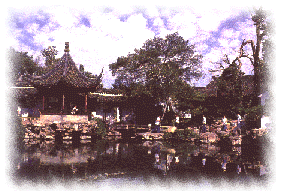 Jiangsu
Jiangsu
|
Jiangsu is a region known for its lakes and rivers. There are lots of famous mountains and beautiful waters, such as Zhong Shan, Yuntai Mountain, Hui Mountain, Jin Shan, Jiao Shan, Yu Shan, Lingyan Mountain, Taihu Lake, Xuanwu Lake, and Slim West Lake. This provides good foundation for the construction of gardens. Many famous gardens were built here which attract many tourists to the cities in the province. Visitors may even forget to return when they tour such good places of interest as the historical sites in Nanjing, the capital of six dynasties in history, the classical gardens in Suzhou, Taihu scenery in Wuxi, the ancient city culture in Yanzhou, the remains of the Qing and Tang Dynasties in Xuzhou, the fairyland of sea in Zhenjiang, the caves and bamboo in Yixing, and the ancient Great Channel, which is as famous as the
Great Wall.
Nanjing ("South Capital") is a port on the Yangtze River. It was a capital intermittently for hundreds of years. In 1842, the Treaty of Nanking was signed here ending the 1st Opium War. Nanjing today is a city with broad avenues thickly lined with sycamore trees. The Valley of the Soul Temple is located on a beautiful, wooded area. Ming Tomb is the Mausoleum of the first Ming emperor. There are also the Botanical Garden, Xuanwu Lake, Purple Gold Mountain with the Observatory, the Nanjing City Wall and Drum Tower, the Rain-Flower Martyr's Memorial Park, and Sorrow-Free Lake Park. These are all places full of legends and moving stories from history.
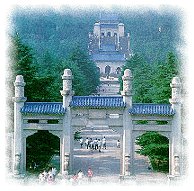 the Dr. Sun Yat-sen Mausoleum
the Dr. Sun Yat-sen Mausoleum
|
The Dr. Sun Yat-Sen Mausoleum, a tribute to China's great revolutionary forerunner (1866-1925), was built during the years of 1926-1929 on the southern slopes of Zhongshan Hill in the eastern suburbs of Nanjing. Now designated as a national scenic spot and historical site, the mausoleum towers at a height of 73 meters at an altitude of 158 meters above sea level. There are 392 granite steps leading to the memorial hall and a vault where the remains of Sun Yat-sen are buried under a marble statue of the leader in a reclining posture. The entire Mausoleum covers an area of 80,000 square meters.
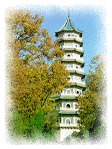 the Linggu Temple
the Linggu Temple
|
The architectures are arranged in the form of a freedom bell, with green foliage as the backdrop as it is overlooking the plain. Its solemnity and magnificence inspires awe.
The Linggu Temple is located 2 kilometers east of the Sun Yat-Sen Mausoleum and was built in 514. The temple is famous for its Beamless Hall, a 22-meter-high brick building without a single beam or an inch of wood. Other attractions here include a pavilion named "Soughing of the Wind in the Pines" and the Lingqu Pagoda.
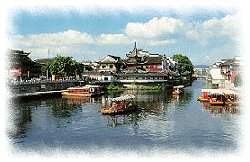 the Qinhuai River
the Qinhuai River
|
The Qinhuai River flows for five kilometers through the southern part of Nanjing City. During its booming years from the 14th to the early 20th centuries, shops, restaurants, and brothels flourished along its banks. The beautiful lantern boats that frolicked on the Qinhuai River were next to none in color and artistry. After recent renovation, the Qinhuai River has regained its former attractiveness with many of its famous sites restored.
Wuxi, one of the oldest cities in China, was founded over 3000 years ago. Its Taihu Lake is where many of China's best gardens, including the Summer Palace, get their rockeries. Its classical Chinese gardens are small but lovely. The Li Garden, Plum Garden, and Relaxing Garden, once private gardens, now attract millions of tourists each month. On the 2210-square-meter Taihu Lake are islets, temple, and pavilions. Locally made are delicate clay figurines, freshwater pearls, and silk
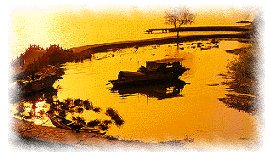 Taihu Lake
Taihu Lake
|
Designated as a national scenic area, Taihu Lake is China's third largest freshwater lake with a water surface area of 2,250 square meters. The vast lake straddles the Jiangsu and Zhejiang provinces. The city of Wuxi on its northern shore is the most splendid part of the lake. Three islets in the lake appear like the head, body, and tail of a tortoise, attracting numerous visitors who can ferry over by boat.
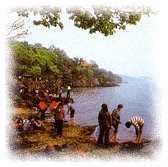 Yuantouzhu
Yuantouzhu
|
Yuantouzhu, a lakeside scenic spot, is actually where Chong Shan extends into a lake. Yuantou in Chinese means "tortoise head," and that's what the rocks here resemble. Of the many famous sites in this 20,000-square-meter lakeside park is a huge rock carved with four huge Chinese characters. They indicate that the lake embraces both Wu and Yue, the two ancient states that are now the Jiangsu and Zhejiang provinces. Yuantouzhu is reputed as the most superb of all the sites in Taihu Lake.
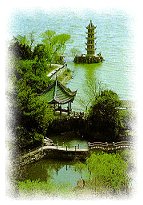 Liyuan Garden
Liyuan Garden
|
The Liyuan Garden is one of the most famous gardens and lies south of the Yangtze River and next to Yuantouzhu. The garden got its name from Fan Li, a prominent minister of the State of Yue 2,490 years ago who often boated on the lake with his lover, a famous beauty of the time by the name of Xishi. Liyuan Garden is surrounded by water on three sides, giving the garden a unique style and elegance. A winding corridor is a thousand meters long, and it has brick inscriptions in the handwriting of famous ancient calligraphers such as Su Dongpo and Mifu and a white wall with 89 window openings latticed with different designs and patterns. These are some of the the garden's exquisite attractions.
Jichang Garden is a well-known garden of classical South China style situated in the eastern foothills of Hui Shan in Wuxi. Built between the years of 1506 and 1521 during the Ming Dynasty, it occupies no more than 10,000 square meters of land. Yet thanks to the ingenuity of its designer, the garden is cleverly integrated with the surrounding landscape that includes the nine peaks of Long Mountain and the Dragon Light Pagoda on Xi Shan. The Qing Emperor, Qian Long who reigned from 1736 to 1795, was so impressed with the garden that he ordered an imitation of the garden to be built in the Summer Palace in Beijing. It was named Xiequyuan or 'Garden of Harmonious Interest.'
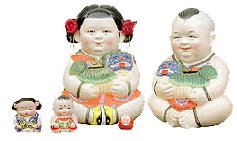 the Huishan Figurines
the Huishan Figurines
|
The lifelike, colored figurines of the Huishan Clay Sculpture Factory are a special art of Wuxi, having a history of more than 400 years. The clay figures are well-known in China and abroad for their romantic style. Most famous among the traditional products are the 'Lao Shou Xing' or the 'Old Man of Longevity' and the 'Da A Fu', a plump little boy holding a fish or a peach, indicating prosperity. A visit to the Huishan Clay Sculpture Factory will give you a unique artistic experience as well as an opportunity to purchase some of these fine souvenirs.
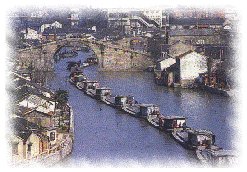 Suzhou
Suzhou
|
Suzhou was an ancient capital that was founded in 514 BC. Criss-crossed by many canals, the city is called the Oriental Venice. It is one of the prettiest cities in China with its tree-lined streets, carved-arch bridges, tiny, white-washed houses, and classical gardens. With fancy-shaped rockeries, curled-roof pavilions painted in soothing and harmonious colors, gentle lotus flowers, and elaborately paved winding walkways, the gardens concentrate landscapes into an area of one or two acres. The Tiger Hill, with a Leaning Tower, is also attractive. Cold Mountain Temple and West Garden Temple have a lot of interesting stories to offer. There are
Grand Canal Boat Tours. Suzhou is the ideal place to buy silk garments, sandalwood, and silk fans. Its embroidery, called Su Embroidery, will surely win the hearts of many ladies by its rich colour and elegant style.
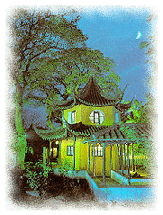 the Hanshan Temple
the Hanshan Temple
|
The Hanshan Temple was built in the region of Tianjian from 502 to 519 during the Liang Dynasty. The temple is located in Fengqiao Town, five kilometers west of Suzhou. It is named after Hanshan, one of two high priests in the Tang Dynasty who are said to have lived and conducted prayer services here. Ever since the Tang poet Zhang Ji wrote in his poem these lines:
From Hanshan Temple in the outskirts of Suzhou,
the bell peals forth to the passenger's sail at midnight.
the temple, along with the verses, become known far and wide. Among the relics here are the famous bell of the Hanshan Temple, stone statues of Hanshan and his friend Shide, as well as an archive of Buddhist scriptures.
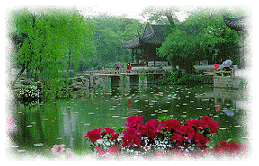 Zhou Zheng Yuan
Zhou Zheng Yuan
|
The largest classical style garden in Suzhou, Zhou Zheng Yuan is one of the four most famous gardens of China, the other three being Yi He Yuan (the Summer Palace) in Beijing, the Mountain Resort of Chengde, and Liuyuan in Suzhou. Built during the reign of Zhengde (1506 to 1521) of the Ming Dynasty, it covers an area of about 40,000 square meters,, three-fifths of which is water. In fact, all its main architecture are is built on the banks of ponds and streams. For its natural simplicity and unique style, it is considered the "quintessence of gardens."
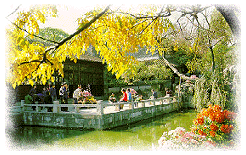 Liuyuan, Lingering Garden
Liuyuan, Lingering Garden
|
Also one of the top four, the Liuyuan Garden (garden in which to linger) was built during the reign of Jiaqing (1522 -1566) of the Ming Dynasty and covers an area of 33,000 square meters. Among the attractions here are the Nanmu Hall, known for its spaciousness; the Mandarin Duck Hall; exquisitely beautiful; and the "Peak Above the Clouds," a huge piece of rock that is reputed to be the largest single rock south of the Yangtze River ever to be hauled from a lake. The garden is intricately designed, providing a different scene at every turn.
Suzhou Embroidery is one of China's four famous schools of embroidery, the others being in Hunan, Sichuan, and Guangdong. With a history that exceeds 2,000 years, Suzhou Embroidery is considered the "Pearl of Oriental Art" for its beautiful designs, varied stitches, superb workmanship, and elegant colors. This insititue conducts research in embroidery and is from where many of the gifts presented by state leaders to distinguished foreign guests come.
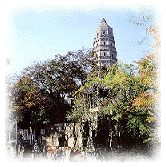 Huqiu, Tiger Hill
Huqiu, Tiger Hill
|
Huqiu, or "Tiger Hill," is known as the number one scenic spot in Suzhou and is located in the northwest outskirts of the city. Standing 26 meters high and covering an area of 200,000 square meters, it boasts 18 sites of natural beauty and historical fame, such as the Hall of Broken Beam, the Honest Spring, and the Sword Testing Stone, each with an individual story. On the hilltop is an octagonal pagoda seven stories high. Towering 47.5 meters over the city, this ancient pagoda, built in 96,1 has become the symbol of Suzhou.
Yangzhou, 20 kilometers north of the Yangtze on the Grand Canal, is 2400 years old and is famous for its gardens and pavillions. Emperors used to often come here. The Five Pavilion Bridge in full moonlight brings back nostalgic memories of the good old time. Guang Ling is the only place in China where one can view the Song Dynasty printing process. The lacquerware, jade carving, paper cuttings, and potted landscapes made in Yangzhou are the finest arts and crafts.
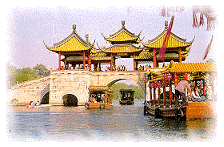 Shoui Lake
Shoui Lake
|
The Shoui Lake is Yangzhou's well-known scenic spot, a classical lake garden incorporating the magnificence of northern landscape and the lyrical beauty of the south. The lake is a slendid strip extending for 4.3 kilometers and is lined with willow trees. Its sceneries lured Emperor Qian Long of the Qing Dynasty to stop here on his inspection tours of the south. Visitors today can trace the footsteps of the emperor as they explore the many hills, pavilion, and towers.
The Daming Temple is a famous Buddhist temple built during the early part of the northern and southern dynasty period (420-589). This is where the young Jianzhen studied and later lectured on Buddhist texts. After five failures, Jianzhen succeeded in crossing the sea to Japan where he built Toshodaiji Temple in Nara. He was a great influence on Japanese Buddhism. In 1973 a Jianzhenheshang Memorial Hall was built within the Daming Temple in commemoration of renewed Japanese and Chinese relations.
Zhenjiang is a city where the Grand Canal meets the south bank of the Yangtze. Many battles were fought here. Toward the end of the first Opium War, it was the only city that strongly resisted the foreign powers. It is bound on three sides by hills and on the north by the Yangtze River. From its three hills, one can get magnificent views of the Yangtze.
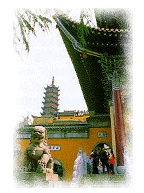 Jinshan Hill
Jinshan Hill
|
Jinshan Hill rises on the southern bank of the Yangtze River 3 kilometers northwest of Zhenjiang City. With an altitude of only 44 meters and a circumference of 520 meters, the hill itself is hardly worth boasting about. What has made it famous is its Jingshan Temple which dates back to the Eastern Jin Dynasty (317-420). Built against the hill, the two seem to merge as one. People have described it as the temple that embraces the hill. At the top of the hill is the 30-meter-tall Cishou Pagoda, the Pagoda of Benevolence and Longevity, and the Liu Yun (Keep the Clouds) Pavilion with an inscription by emperor Kang Xi who reigned from 1662 to 1722. It reads: "Taking in the River and Heaven at One Glance".
 Jiaoshan Hill
Jiaoshan Hill
|
Jiaoshan Hill stands right in the middle of the Yangtze River, 5 kilometers northeast of Zhenjiang. It is 71 meters high and has a circumference of 2,000 meters. Covered with green foliage, it appears as a piece of floating green jade on the river and has indeed earned the name of "the Floating Jade Hill." On its southern foothill is the thousand-year-old Dinghui Temple. Because it is half hidden by the verdure, it has been described as the temple embraced by the hill. Jiaoshan has long been known for its enchanting natural beauty, ancient temples, rock carvings, and stele forests and has attracted visitors for over one thousand years.



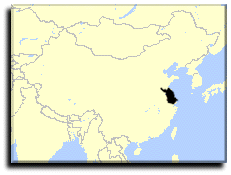




















 Chinese Culture
Chinese Culture